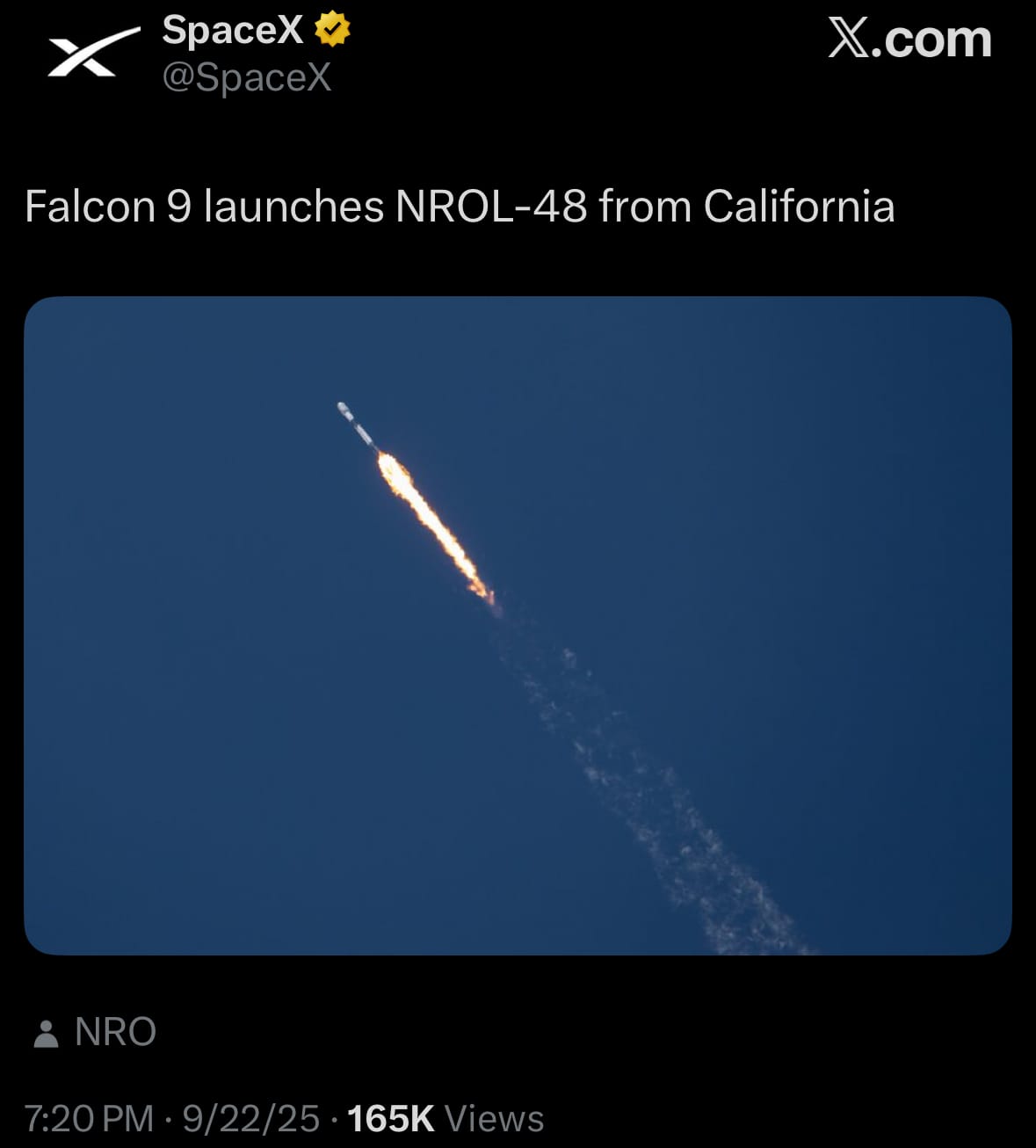Tuesday☕️

Economics & Markets:
- Yesterday’s U.S. stock market:

- Yesterday’s commodity market:

- Yesterday’s crypto market:

Geopolitics & Military Activity:
- Yesterday, September 22, 2025, Russian officials confirmed that the final S-400 Triumf air defense system under a 2018 contract with India, valued at USD 5.43 billion, will be delivered by 2026, completing the supply of all five units after four have already been provided and integrated. The S-400 system offers advanced long-range capabilities to counter aircraft, drones, and ballistic missiles, strengthening India's border defenses in response to regional tensions with neighbors such as China and Pakistan. Initial delays in the delivery schedule were linked to the ongoing Russia-Ukraine conflict and related logistical challenges, but both nations have maintained their commitment to the agreement despite external pressures.
- This deal highlights the enduring strategic partnership between India and Russia, with Russia continuing as a major arms supplier even as India diversifies its procurements from other sources. Discussions for potential additional systems, aircraft upgrades, and joint manufacturing initiatives are ongoing, aligning with India's focus on domestic production. The arrangement has faced international scrutiny, including from the United States over sanctions concerns, but it has been managed to preserve broader geopolitical balances in the Indo-Pacific region, potentially influencing South Asian security dynamics without favoring any single perspective on its implications.
Environment & Weather:


Cyber:
- On September 21, 2025, automotive giant Stellantis disclosed a data breach involving unauthorized access to a third-party Salesforce database, exposing customer contact information for an unspecified number of North American individuals linked to brands such as Jeep, Fiat, Chrysler, Dodge, and Ram. The cybercriminal group ShinyHunters claimed responsibility on September 22, 2025, stating they had stolen over 18 million records as part of a broader series of attacks on Salesforce clients. Stellantis clarified that the compromised data was restricted to names and basic contact details, excluding sensitive financial or identification information, and the breach was identified through routine monitoring, leading to immediate notifications to affected customers and no detected misuse at the time.
- This incident underscores persistent vulnerabilities in third-party platforms relied upon by major corporations, heightening risks of phishing or identity theft for impacted car buyers, and it aligns with ShinyHunters' pattern of targeting similar systems. Stellantis is working with authorities, urging customers to watch for suspicious activity, and the event could invite regulatory reviews under data privacy regulations in North America and Europe. It reflects wider industry struggles to protect supply chain integrations against escalating cyber threats, without attributing blame to particular parties.
Space:

- On September 22, 2025, SpaceX conducted a successful launch of the NROL-48 mission using a Falcon 9 rocket from Space Launch Complex 4 East at Vandenberg Space Force Base in California, lifting off at 10:38 a.m. Pacific Daylight Time. The mission delivered an unspecified number of reconnaissance satellites into a low Earth sun-synchronous orbit, supporting the National Reconnaissance Office's initiative to build a network of smaller, more distributed satellites for enhanced intelligence gathering. The rocket's first-stage booster, on its 18th flight, separated as planned and landed back at Landing Zone 4 on the base despite foggy conditions.

- The National Reconnaissance Office, established in 1961 as a U.S. intelligence agency under the Department of Defense, is responsible for the design, acquisition, launch, and operation of the nation's reconnaissance satellites to collect space-based intelligence. Its missions focus on providing timely and accurate data to support national security, including imagery intelligence for visual monitoring, signals intelligence for intercepting communications, and geospatial intelligence for mapping and analysis, which aids policymakers, military operations, and other intelligence community partners. The NRO's capabilities have evolved from relying on a few large, complex satellites to a proliferated architecture involving hundreds of smaller, cost-effective units co-developed with industry partners like SpaceX, aiming to improve resilience against potential threats and ensure continuous coverage in various global scenarios.
Statistic:
- Largest public automakers by market capitalization:
- 🇺🇸 Tesla: $1.443T
- 🇯🇵 Toyota: $261.56B
- 🇨🇳 Xiaomi: $188.02B
- 🇨🇳 BYD: $137.08B
- 🇮🇹 Ferrari: $86.10B
- 🇩🇪 BMW: $59.24B
- 🇩🇪 Mercedes-Benz: $57.74B
- 🇮🇳 Maruti Suzuki India: $56.33B
- 🇺🇸 General Motors: $56.15B
- 🇩🇪 Volkswagen: $52.72B
- 🇮🇳 Mahindra & Mahindra: $49.42B
- 🇺🇸 Ford: $46.24B
- 🇯🇵 Honda: $43.82B
- 🇩🇪 Porsche: $43.59B
- 🇰🇷 Hyundai: $38.82B
- 🇨🇳 Seres Group: $33.22B
- 🇨🇳 SAIC Motor: $30.80B
- 🇮🇳 Tata Motors: $29.04B
- 🇰🇷 Kia: $28.79B
- 🇳🇱 Stellantis: $28.69B
- 🇯🇵 Suzuki Motor: $27.98B
- 🇨🇳 Great Wall Motors: $26.67B
- 🇨🇳 Li Auto: $25.93B
- 🇮🇳 Hyundai Motor India: $25.05B
- 🇨🇳 Geely: $24.34B
History:
- The history of U.S. drone warfare began with experimental concepts like the “Kettering Bug” in World War I and radio-controlled aircraft in the interwar years, which laid the groundwork for later unmanned aerial vehicles (UAVs). During the Cold War, drones such as the Ryan Firebee were used for reconnaissance over high-risk areas, while the Vietnam War tested their potential in combat zones. By the 1990s, the U.S. had developed the RQ-1 Predator, a long-endurance drone used for intelligence, surveillance, and reconnaissance (ISR). A major turning point came in 2001, when the Predator was armed with AGM-114 Hellfire missiles. This gave the U.S. military its first true remotely piloted strike capability, used in Afghanistan and Yemen shortly after. The MQ-9 Reaper, introduced in the mid-2000s, expanded on this with greater range, payload, and lethality, becoming central to counterterrorism and targeted strike operations around the world.
- Since then, drone warfare has grown into a core part of U.S. military power and defense industry innovation. The initial model of combining ISR with precision strikes has evolved into a broad ecosystem of unmanned systems. Defense giants such as Lockheed Martin, Northrop Grumman, Boeing, Raytheon, and General Atomics continue to refine high-end drones, while newer companies like Anduril, Shield AI, and Skydio push the frontier with autonomous swarming drones, AI-powered surveillance, and collaborative combat systems. Today, drones are designed not only for reconnaissance or precision strikes but also for electronic warfare, loyal wingman roles alongside crewed aircraft, and swarm tactics where dozens of small drones can overwhelm defenses or conduct coordinated missions. What started as a reconnaissance tool has now become a sophisticated, software-driven capability spanning surveillance, strike, and autonomy, reshaping how the U.S. projects military power.
Image of the day:

Thanks for reading!
Earth is complicated, we make it simple.
Monitor the planet with the Earth Intelligence System. Click the image below to view the Earth Intelligence System:



Support/Suggestions Email:
earthintelligence@earthintel.news




